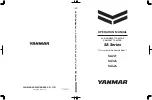
WARNING
POTENTIAL HAZARD
Try to stop the tipping vehicle with your arm or leg.
WHAT CAN HAPPEN
You could be severely injured. You could suffer a crushed hand, arm, leg, foot.
HOW TO AVOID THE HAZARD
You must keep your arms and legs inside the vehicle until it stopped moving.
As with any off-road vehicle, there is a risk of tip over or rollover under certain
conditions. Uneven terrain or slopes which pitch the vehicle sideways, turning
too fast or sharp, or a combination of conditions increase the risk of tip over.
If you are in a situation where the vehicle is tipping over, do not put your arm
or/ and leg outside the vehicle, do not try to stop tipping with your arm or leg.
You could be severely injured. You could suffer a crushed hand, arm, leg, or
foot, if part of your body is caught underneath the vehicle.
RIDING THROUGH SHALLOW WATER
If you must cross shallow, slow moving water up to 200mm depth, choose your
path carefully to avoid sharp drop-offs, large rocks, or slippery surfaces that
could cause the vehicle to overturn. Never operate through water deeper than
200mm or fast flowing water. Wet brakes may have reduced effectiveness.
After leaving the water, test your brakes. If necessary, apply the brakes
several times to let friction dry out the brake pads.
NOTE:
After running the vehicle in water, it is critical your machine is
serviced as outlined in the Maintenance chart. Following areas need special
attention: engine oil, transmission oil, rear gearcase, and all grease fittings.
WARNING
POTENTIAL HAZARD
Operating this vehicle in deep or fast-flowing water.
WHAT CAN HAPPEN
Loss of control which could result in an accident including overturn, which
could increase the risk of drowning
.
HOW TO AVOID THE HAZARD
Never operate this vehicle in fast flowing water or in water deeper than 20 cm.
Remember that wet brakes may have reduced stopping ability. Test your
brakes after leaving water. If necessary, apply brakes several times to let
friction dry out the brake pads.
Summary of Contents for T-Boss570
Page 12: ...1 2 NOTE Maximum tire pressure Front 48 3 kPa Rear 48 3 kPa...
Page 13: ...3 4 5 6 7...
Page 14: ...8 9 10 11...
Page 15: ...12 13 14 15...
Page 16: ...16 17 18...
Page 108: ...TOOLS SUPPLIED WITH THE VEHICLE...
















































